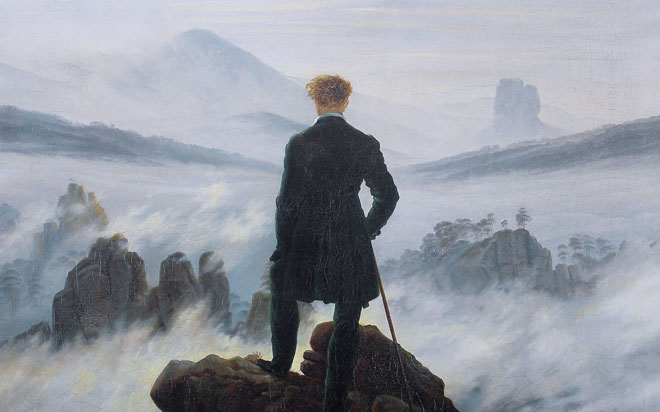Future Now
The IFTF Blog
The Stories of Our Time
The following was inspired by a presentation about the power of storytelling by Kendall Haven.

Caspar David Friedrich, The wanderer above the sea of fog. 1818, Oil-on-canvas.
Once upon a time, an organism evolved to have a brain hard-wired to think and communicate in narrative form. These organisms interacted with their environment in a myriad of ways, using their hands to develop weapons for hunting and plows for agriculture. These organisms were capable of the most wonderful compassion at the best of times, and the most horrific violence at the worst of times. As these organisms explored the extent of their lands, they drew boundaries between communities and created nation states.
One of these nations, the Great Nation, prevailed over others, with the most advanced trade routes and the most sophisticated scientific, entertainment, and military technologies. One day, a rogue Tribe of a smaller nation attacked the Great Nation. This hurt the Great Nation very much. The leader of the Great Nation, and all of the leader's advisers, believed that retaliation should be swift and decisive, so the Great Nation invaded the smaller nation where the Tribe lived. The retaliation appeared to work at first, and the leader of the Great Nation declared "Mission Accomplished." But the Great Nation continued to retaliate over the years, because it seemed to some that the mission was not yet accomplished. Even the most advanced military forces of the Great Nation, fueled by the most powerful trade routes, could not overcome the Smaller Nation.
One day, a new leader was elected to preside over the Great Nation, and the advisers began to wonder why, with the most powerful military and the most profitable trade routes, why could the Great Nation not conquer the Tribe of the smaller nation? Some of the advisors wondered if perhaps this could be because the Tribe of the smaller nation had something that could not be bought with trade or forced with military. Perhaps, the Tribe of the smaller nation had better stories.
The advisers wanted to better understand the power of stories, so they convened a Workshop of the Great Nation's brightest minds. They decided that to understand the Tribe's stories it was "essential to use a multi-method, multi-disciplinary approach that specifically focuses on the complex relationships between attitude and intent formation and, ultimately, behavior manifestation. Thus, panelists were purposely selected from diverse disciplines and backgrounds."1
The Great Nation's workshop discussed the power of story telling at great length. They peered deep into the brain and glimpsed the neurobiological mechanisms that allowed one organism to hurt another, as the Tribe hurt the Great Nation and vice versa. They tested the mind and pondered ways that they could tell stories better than the smaller nation. This workshop led the Great Nation to dive deeper into storytelling, and explore the idea with their most Advanced Research Projects Agency that deals with Defense.2 The Agency asked people of the great nation to help them think of state of the art ways to tell better stories, and to detect when people are under the influence of powerful stories from the radical Tribe.
During the Great Nation's workshop, participants had discussed how really great stories cause the brain to release dopamine and oxytocin. This lead someone working with the Agency to wonder if they could control or inhibit the release of dopamine or oxytocin. Releasing more dopamine and oxytocin could make a person like a story, or perhaps inhibiting dopamine and oxytocin could make the same person dislike the same story that they had just liked the moment before. A researcher working with the Agency tested to see what happens when oxytocin is sprayed into a person's nose instead of coming from the brain. But they also said that the Great Nation is not looking to “...just spray oxytocin into the crowds. That, first of all, would be highly unethical and illegal, and it wouldn’t work anyway. You have to get a lot into the brain.“3
Some people in the Great Nation and around the world were intrigued and fascinated by the Agency's quest for better storytelling, and some people were terrified, not knowing whether to "laugh or cry or be alarmed."4 But the Great Nation's Agency told the people that it would be okay, they said, "We’re not in the business of reading people’s minds, or implanting thoughts. By understanding the biology of what causes people go to war, we might begin to understand how to mitigate it.”3 The Great Nation began to realize that fighting the Tribe with force may not be the path to victory, and perhaps writing a better narrative is the answer.
One day, Kendall Haven, a person helping the Agency, came to visit the Institute for the Future. Kendall told us his version of this story, and shared some tips on good storytelling. Though the Q&A went on past the allotted time, the people of the Great Nation, and the Tribe of the smaller nation still do not know how this story ends. It is up to us to listen to one another's stories and to make our own stories. If the stories we tell are not just good, but they are great, then perhaps they will make the world a better place.
1) "Narrative Networks - Federal Business Opportunities." FedBizOpps , October 7, 2011.
2) Baker, Tessa "The Neurobiology of Political Violence: New Tools, New Insights." NSI (PDF), December 2, 2010.
3) Weinberger, Sharon. "Building the Pentagon's ‘like me’ weapon." BBC Homepage, May 2, 2012.
4) Yirka, Bob. "DARPA looking to master propaganda via 'Narrative Networks'." Phys.org, October 20, 2011.



